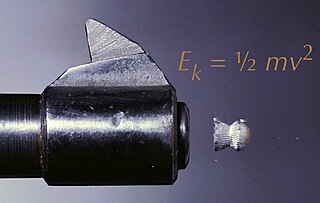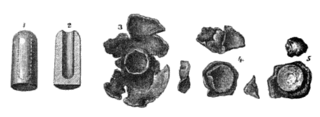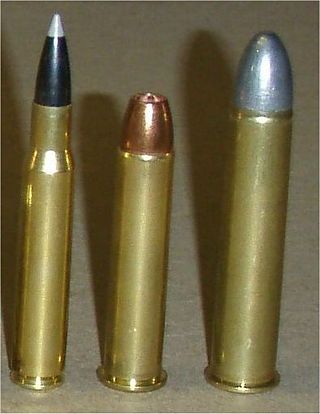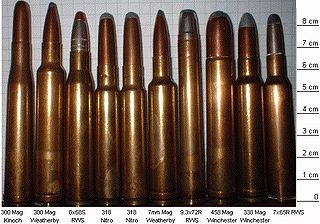
An elephant gun is a large caliber gun, rifled or smoothbore, originally developed for use by big-game hunters for elephant and other large game. Elephant guns were black powder muzzle-loaders at first, then black powder express rifles, then later used smokeless powder cartridges.

The .460 Weatherby Magnum is a belted, bottlenecked rifle cartridge, developed by Roy Weatherby in 1957. The cartridge is based on the .378 Weatherby Magnum necked up to accept the .458-inch (11.6 mm) bullet. The original .378 Weatherby Magnum parent case was inspired by the .416 Rigby. The .460 Weatherby Magnum was designed as an African dangerous game rifle cartridge for the hunting of heavy, thick skinned dangerous game.

Muzzle energy is the kinetic energy of a bullet as it is expelled from the muzzle of a firearm. Without consideration of factors such as aerodynamics and gravity for the sake of comparison, muzzle energy is used as a rough indication of the destructive potential of a given firearm or cartridge. The heavier the bullet and especially the faster it moves, the higher its muzzle energy and the more damage it will do.

The term express was first applied to hunting rifles and ammunition beginning in the mid-19th century, to indicate a rifle or ammunition capable of higher than typical velocities. The early express cartridges used a heavy charge of black powder to propel a lightweight, often hollow point bullet, at high velocities to maximize point blank range. Later the express cartridges were loaded with nitrocellulose-based gunpowder, leading to the Nitro Express cartridges, the first of which was the .450 Nitro Express.

The .45-70, also known as the .45-70 Government, .45-70 Springfield, and .45-21⁄10" Sharps, is a .45 caliber rifle cartridge originally holding 70 grains of black powder that was developed at the U.S. Army's Springfield Armory for use in the Springfield Model 1873. It was a replacement for the stop-gap .50-70 Government cartridge, which had been adopted in 1866, one year after the end of the American Civil War, and is known by collectors as the "Trapdoor Springfield".

The .458 Winchester Magnum is a belted, straight-taper cased, Big Five game rifle cartridge. It was introduced commercially in 1956 by Winchester and first chambered in the Winchester Model 70 African rifle. It was designed to compete against the .450 Nitro Express and the .470 Nitro Express cartridges used in big bore British double rifles. The .458 Winchester Magnum remains one of the most popular large game cartridges, and most major ammunition manufacturers offer a selection of .458 ammunition.

The 7mm-08 Remington is a rifle cartridge that is almost a direct copy of a wildcat cartridge developed around 1958 known as the 7mm/308. As these names would suggest, it is the .308 Winchester case necked down to accept 7 mm (.284) bullets with a small increase in case length. Of cartridges based upon the .308, it is the second most popular behind only the .243 Winchester. However, the .308 is more popular than both. In 1980, the Remington Arms company popularized the cartridge by applying its own name and offering it as a chambering for their Model 788 and Model 700 rifles, along with a limited-run series within their Model 7600 pump-action rifles during the early 2000s.
The .416 Rigby is a rifle cartridge designed in 1911 by London based gunmaker John Rigby & Company, for hunting dangerous game. It is the first cartridge to use a bullet of .416 inch diameter. The rifles, as built by John Rigby & Co., were initially made up on the Magnum Mauser 98 action, although in later years, some were made on standard length actions, a perfect example being the rifle used by legendary professional hunter Harry Selby. Other famous users of the cartridge were Commander David Enderby Blunt, John Taylor, and Jack O'Connor.
The .600 Nitro Express (15.7x76mmR) is a large bore Nitro Express rifle cartridge developed by W.J. Jeffery & Co for the purpose of hunting large game.
The .577 Nitro Express is a large-bore centerfire rifle cartridge designed for the purpose of hunting large game such as elephant. This cartridge is used almost exclusively in single-shot and double express rifles for hunting in the Tropics or hot climates in general and is a cartridge associated with the golden age of African safaris and Indian shikars.

The .375 H&H Magnum, also known as .375 Holland & Holland Magnum, is a medium-bore rifle cartridge introduced in 1912 by London based gunmaker Holland & Holland. The .375 H&H cartridge featured a belt to ensure the correct headspace, which otherwise might be unreliable, given the narrow shoulder of the cartridge case. The cartridge was designed to use cordite which was made in long strands – hence the tapered shape of the case, which, as a beneficial side effect also helped in smooth chambering and extraction from a rifle's breech.

The 7mm Remington Magnum rifle cartridge was introduced as a commercially available round in 1962, along with the new Remington Model 700 bolt-action rifle. It is a member of the belted magnum family that is directly derived from the venerable .375 H&H Magnum. The original purpose of the belted magnum concept taken from the .300 H&H Magnum and .375 H&H Magnum, was to provide precise headspace control, since the sloping shoulders, while easing cartridge extraction, were unsuitable for this purpose. Improved cartridge extraction reliability is desirable while hunting dangerous game, in particular when a fast follow-up shot is required. The 7mm Remington Magnum is based on the commercial .264 Winchester Magnum, .338 Winchester Magnum, and .458 Winchester Magnum, which were based on the same belted .300 H&H Magnum and .375 H&H Magnum cases, trimmed to nearly the same length as the .270 Weatherby Magnum.

The 9.5×57mm Mannlicher–Schönauer (MS) cartridge was adopted for the M-1910 MS rifle and carbine in 1910. The 9.5×57mm MS is also known as the 9.5×56mm MS, the 9.5×56.7mm MS, and the .375 Rimless Nitro Express (RNE) × 2¼. The cartridge may have been created by Westley-Richards and Eley in 1908, but no production rifles in this caliber have been found prior to the M-1910. This development by or on behalf of Steyr was probably an answer to the development by the noted British gunmaking firm of Holland & Holland in 1905 of their .400/375 Belted Nitro Express, designed for their specially modified Mannlicher–Schoenauer rifle. Whether the development of the 9.5×57mm Mannlicher–Schoenauer cartridge originated with OWS or with Holland's British competitor, Westley Richards certainly was the principal promoter of the new 1910 Model Mannlicher–Schoenauer rifle as evidenced by catalogs of the time. The 9.5×57mm MS is the last pre-war proprietary cartridge by Steyr and their most powerful until the recent advent of the .376 Steyr, which has its antecedents in the 9.5×57mm.
.450 Nitro Express also known as the .450 Nitro Express 31⁄4-inch is a rifle cartridge designed for hunting dangerous game such as elephant, rhino, cape buffalo, lion, and leopard. This cartridge is used almost exclusively in double rifles for hunting in the tropics or hot climates in general and is associated with the Golden Age of African safaris and Indian shikars.

The .404 Jeffery is a rifle cartridge designed for hunting large, dangerous game animals, such as the "Big Five" of Africa. The cartridge is standardized by the C.I.P. and is also known as .404 Rimless Nitro Express. It was designed in 1905 by London based gunmaker W.J. Jeffery & Co to duplicate the performance of the .450/400 Nitro Express 3-inch in bolt-action rifles. The .404 Jeffery fired a bullet of .422 in (10.72 mm) diameter of either 300 gr (19 g) with a muzzle velocity of 2,600 ft/s (790 m/s) and muzzle energy of 4,500 foot-pounds force (6,100 N⋅m) or 400 gr (26 g) with a muzzle velocity of 2,150 ft/s (660 m/s) and 4,100 foot-pounds force (5,600 N⋅m) of energy. It is very effective on large game and is favored by many hunters of dangerous game. The .404 Jeffery was popular with hunters and game wardens in Africa because of its good performance with manageable recoil. By way of comparison, the .416 Rigby and .416 Remington Magnum cartridges fire .416 in (10.57 mm) bullets of 400 gr at 2,400 feet per second (730 m/s) with a muzzle energy of approximately 5,000 foot-pounds force (6,800 N⋅m). These cartridges exceed the ballistic performance of the .404 Jeffery but at the price of greater recoil and, in the case of the .416 Rigby, rifles that are more expensive.

The .500 Nitro Express is a rifle cartridge designed for hunting large and dangerous game animals in Africa and India. This cartridge was primarily designed for use in double rifles though various single shots were produced on the Farquarson action and at least one major company (Heym) produced it in bolt-action configuration. It was commonly available in two lengths: a 3.00 in (76 mm) and a 3.25 in (83 mm) version.
The .500 Jeffery (12.7x70mmRB) is a big-game rifle cartridge that first appeared around 1920, and was originally introduced by the August Schuler Company, a German firm, under the European designation "12.7×70mm Schuler" or ".500 Schuler". When offered by the famed British outfitter W.J. Jeffery & Co, it was renamed the .500 Jeffery so as to be more palatable to British hunters and sportsmen following World War One.
The .400 Jeffery Nitro Express or .450/400 Nitro Express 3-inch is a medium bore, bottlenecked, Nitro Express cartridge designed by W.J. Jeffery & Co in 1902, intended for use in single shot and double rifles.

The .318 Westley Richards, also known as the .318 Rimless Nitro Express and the .318 Accelerated Express, is a proprietary medium bore centerfire rifle cartridge developed by Westley Richards.
The .350 Rigby and .350 Rigby No 2 are proprietary medium bore rifle cartridges developed by John Rigby & Company.

















